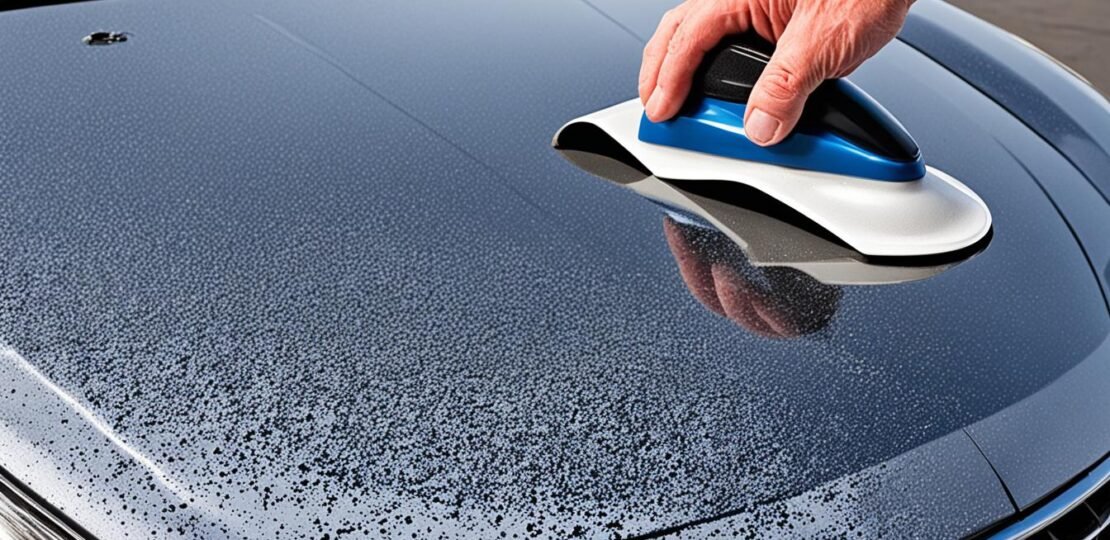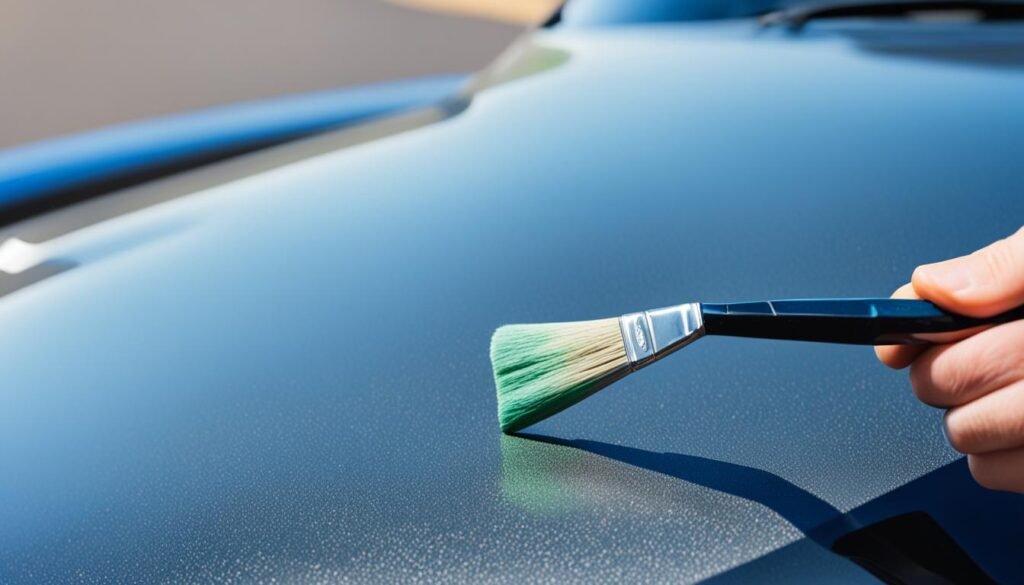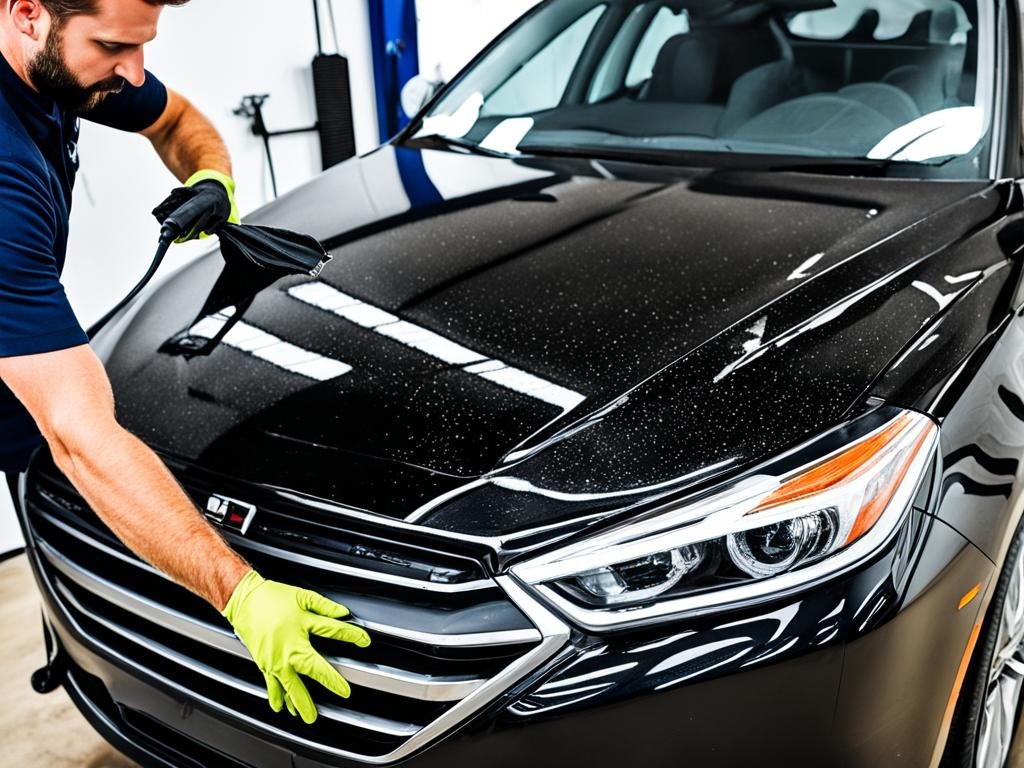Buff Out Paint Imperfections: Easy DIY Guide
March 9, 2024 | by spousingitup

Did you know that 77% of cars on the road have some form of paint imperfection? Whether it’s small scratches, swirl marks, or faded paint, these imperfections can detract from the overall appearance of your vehicle. But fear not! In this easy DIY guide, we’ll show you how to buff out paint imperfections and restore your car’s paint finish to its original pristine condition.
Key Takeaways:
- Learn how to remove scratches from car paint using paint correction techniques.
- Understand the importance of measuring paint thickness and preparing the surface before buffing.
- Discover the best polishing and finishing techniques to achieve a flawless finish.
- Find out how to deal with deep scratches and stone chips.
- Remember to follow regular auto detailing tips and maintenance to keep your car looking its best.
Understanding Paint Thickness and Surface Preparation
Before we dive into the process of buffing out paint imperfections, it’s crucial to have a solid understanding of paint thickness and surface preparation. These initial steps are essential for achieving a flawless finish on your vehicle’s paint job.
One of the first things to consider is measuring the paint thickness. By using a paint thickness gauge, you can determine the amount of material that can be safely removed during the buffing process. This tool provides accurate readings in mils or microns, helping you establish an appropriate polishing strategy while avoiding any damage to the clear coat.
Why Measuring Paint Thickness Matters
Measuring paint thickness allows us to assess the condition of the paint job and determine the appropriate approach for removing imperfections. If the paint is too thin, aggressive polishing could expose the underlying layers and cause irreversible damage. On the other hand, if the paint is too thick, more aggressive polishing may be necessary to achieve desired results.
The Importance of Surface Preparation
In addition to measuring paint thickness, proper surface preparation is key to achieving a professional finish. This involves masking and blocking off sections that do not require polishing to avoid accidentally damaging them. Masking tape and plastic sheeting can be used to protect trims, emblems, and other delicate areas.
Furthermore, thorough cleaning and decontamination of the paint surface are necessary before starting the buffing process. By removing dirt, oil, and other contaminants, you ensure that the paint correction techniques and polishing compounds can work effectively without interference.
| Steps for Surface Preparation: | Benefits of Surface Preparation: |
|---|---|
| 1. Wash the vehicle using a mild detergent and clean water. | – Removes dirt and grime that can hinder the buffing process. |
| 2. Clay the surface to remove embedded contaminants. | – Smoothens the surface and prepares it for polishing. |
| 3. Mask off areas that don’t require polishing. | – Protects delicate trims and prevents accidental damage. |
| 4. Block off adjacent sections to maintain control and prevent cross-contamination. | – Ensures focused polishing and minimizes the risk of spreading compound or polish. |
By taking the time to measure paint thickness and properly prepare the surface, you set a solid foundation for the buffing process. This attention to detail will ultimately lead to better results and ensure the safety of your vehicle’s paint job.
Polishing and Finishing Techniques
Polishing is a crucial step in the process of buffing out paint imperfections. At Rosie Dazzlers Detailing, we pride ourselves on using the most effective techniques to achieve impeccable results. One key tool in our arsenal is the machine polisher, which allows us to work efficiently and achieve a flawless finish.
When it comes to choosing the right pad and compound for your specific needs, there are several factors to consider. The hardness of the paint, the severity of imperfections, and the desired outcome all play a role in determining the best combination of pad and compound.
Working with paint of unknown hardness can present a challenge, as different types of paint require different approaches. To ensure optimal results, our experienced technicians rely on a multi-stage polishing strategy. This involves using various combinations of pads and compounds for heavy cutting, medium cutting, light cutting, and finishing.
| Purpose | Pads | Compounds |
|---|---|---|
| Heavy cutting | Wool pad | Heavy-cut compound |
| Medium cutting | Foam pad | Medium-cut compound |
| Light cutting | Foam pad | Light-cut compound |
| Finishing | Foam pad | Finishing polish |
By utilizing this multi-stage approach, we can effectively address imperfections and restore your vehicle’s paint to a showroom-like shine. Our skilled technicians are well-versed in the intricacies of paint polishing and can achieve outstanding results even on paint of unknown hardness.
We take pride in our attention to detail and our commitment to customer satisfaction. Our meticulous approach ensures that every paint imperfection is addressed, leaving our customers delighted with the results. – Rosie Dazzlers Detailing
Whether you have minor swirl marks or more significant paint imperfections, our polishing and finishing techniques can help bring your vehicle’s paint surface back to its original glory. Trust the experts at Rosie Dazzlers Detailing to deliver exceptional results, leaving your car looking as good as new.

Dealing with Deep Scratches and Stone Chips
Sometimes buffing alone may not be enough to address deep scratches and stone chips that have penetrated the clear coat and reached the color and primer layers. In these cases, additional steps are necessary to repair the affected areas.
To begin the repair process, the first step is sanding the affected area to smooth out any rough edges or uneven surfaces. Using a fine-grit sandpaper, gently sand the area in a circular motion until it becomes smooth and level with the surrounding paint.
Once the area is sanded, it’s time to repair the stone chips. Begin by cleaning the area with a mild soap and water solution to remove any dirt or debris. Then, carefully apply touch-up paint that matches the color of your vehicle using a small brush or a paint pen. Allow the paint to dry completely before moving on to the next step.

After the touch-up paint has dried, it’s time to wet-sand the area to further level the surface. Wet-sanding involves using a wet sanding block or sandpaper soaked in water to gently sand the repaired area. This process helps to blend the new paint with the surrounding surface and achieve a seamless finish.
Once you are satisfied with the levelness of the repaired area, wipe away any residue and apply a clear coat to protect the paint. Allow the clear coat to dry completely before applying any wax or sealant.
Remember, dealing with deep scratches and stone chips requires patience and precision. If you are unsure about performing these repairs yourself, it’s always best to consult a professional auto detailer or body shop to ensure the best results.
Conclusion
At Rosie Dazzlers, we understand that buffing out paint imperfections is a meticulous process that requires expertise and attention to detail. By following our proven techniques for understanding paint thickness, preparing the surface, and applying the correct polishing and finishing methods, you can achieve stunning results.
Our team of experts is well-versed in fixing paint swirl marks, offering effective paint repair solutions, and providing auto detailing tips that can transform your vehicle’s appearance. We believe that regular maintenance and adherence to our recommended paint restoration methods are essential for keeping your car’s paint finish in impeccable condition.
When you choose Rosie Dazzlers, you’re choosing a dedicated team that prioritizes customer satisfaction. We begin our detailing process with exceptional customer service, ensuring that we understand your needs and expectations. Our professional team will work diligently, washing, claying, polishing, and more, until we achieve the flawless finish you desire.
Don’t settle for anything less than perfection. Trust Rosie Dazzlers for all your auto detailing needs. Experience the difference our expertise, precision, and passion can make in restoring your vehicle’s paint to its former glory.
FAQ
How do I buff out paint imperfections on my car?
Buffing out paint imperfections on your car involves several steps. First, measure the paint thickness using a paint thickness gauge to ensure you don’t remove too much material. Then, prepare the surface by masking and blocking off sections. Next, choose the right pad and compound for your needs and use a machine polisher for effective results. Follow a multi-stage polishing strategy for the best outcome. Lastly, address deeper scratches and stone chips with additional repair steps if necessary.
How do I measure the paint thickness on my car?
To measure the paint thickness on your car, you can use a paint thickness gauge. This tool provides accurate readings in mils or microns, helping you determine how much material you can safely remove during the buffing process. It’s essential to have this information to avoid damaging the clear coat and achieve the desired results.
What are the key steps in the buffing process?
The key steps in the buffing process include measuring the paint thickness, preparing the surface, choosing the appropriate pads and compounds, and utilizing a machine polisher. Following a multi-stage polishing strategy and addressing deeper scratches and stone chips are also important aspects of the process. These steps, when executed properly, will help you achieve a flawless finish and restore the appearance of your car’s paint.
How can I deal with deeper scratches and stone chips on my car’s paint?
Deeper scratches and stone chips that have penetrated the clear coat require additional steps to repair. Start by sanding the affected area to level it with the surrounding paint. Then, use touch-up paint to fill in the damaged area. Wet-sanding can be done to further level the area for a smoother finish. By following these steps, you can effectively address deeper scratches and stone chips on your car’s paint.
What are some other paint repair solutions and auto detailing tips?
In addition to buffing out paint imperfections, there are other paint repair solutions and auto detailing tips you can follow. To fix paint swirl marks, you can use a swirl remover product and a microfiber cloth. Regular waxing and polishing can help maintain the paint’s shine. It’s also important to wash your car regularly and protect it from environmental factors such as UV rays and harsh weather conditions. Following these tips will help keep your car’s paint looking great.
Are there any recommended paint restoration methods?
Yes, there are several recommended paint restoration methods. These include using a clay bar to remove contaminants, using a paint cleaner to eliminate oxidation, and using a high-quality polish to restore shine. Additionally, using a paint sealant or ceramic coating can provide long-lasting protection and enhance the gloss of your car’s paint. Consulting with a professional or researching reputable products can help you determine the best paint restoration methods for your specific needs.
Source Links
RELATED POSTS
View all



